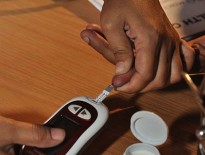
CDC / Dr. David Cox / Public Health Image Library #1977
“Example is the school of mankind, and they will learn at no other.”
– Edmund Burke
Syphilis has been around at least since Europeans arrived in the Western Hemisphere. It’s a sexually transmitted disease caused by Treponema pallidum, a member of a group of corkscrew-shaped bacteria called spirochetes. Sometimes it causes no symptoms at all, but typically it initially causes a painless sore on the mouth or genitals. Later it can cause a rash. Untreated it may lead to blindness, spinal cord and brain damage, and death.
After the discovery of penicillin in the 1940s syphilis was for the first time easily curable and the prevalence of syphilis in the US dropped precipitously.
I trained in the bad-old-days of the mid-90s when HIV was killing tens of thousands of people in the US every year. On every inpatient ward rotation I met patients hospitalized with an opportunistic AIDS-related infection. On every ICU rotation I met patients dying of AIDS. Back then medications to treat HIV were few, new, and only modestly effective. HIV was usually a rapidly fatal disease. It was scary. Counseling patients about condom use and monogamy was not moralistic or theoretical. It had all the practical urgency of yelling at someone to get off the train tracks.
I have no evidence that HIV and the response to it was responsible for the subsequent fall in syphilis infections, but in fact syphilis did decline during the 90s and in 2000 reached its lowest rate ever in the US and was on the verge of being eliminated. You would think that a disease that can be easily diagnosed with blood tests, can be cured with antibiotics, and can be prevented with condoms would be on its way to the dustbin of history. You would be wrong.
This week the Centers of Disease Control and Prevention (CDC) published a review of syphilis trends in the US from 2005 to 2013. The statistics are dismaying. The number of syphilis cases almost doubled during that interval, from 8,724 cases in 2005 to 16,663 in 2013. 91% of the 2013 cases occurred in men. The number of cases in women was about the same in 2013 as in 2005. Of the male cases in 2013, 84% occurred in men who reported having sex with men.
The report breaks down the trends geographically and by ethnicity but it’s the age breakdown that I found fascinating. From 2005 to 2009 men aged 20 to 24 had the greatest percentage increase in syphilis rates, and from 2009 to 2013 men aged 25 to 29 had the greatest increase. But of course those two age categories are actually the same group – men born in the 1980s. I couldn’t help notice that these are the men who grew up after the bad-old-days, the men who think of HIV as the treatable chronic illness it has become, not the death sentence it was 20 years ago.
The CDC report offers wise advice to physicians. We should be testing gay and bisexual men for syphilis at least annually. Men who have multiple partners should be tested more frequently. We should be counseling consistent condom use except in prolonged monogamous relationships in which both partners have been tested.
But perhaps that won’t be enough. I have zero evidence that the attitudes about HIV contributed to the decline of syphilis in 2000 or its resurgence now, but the time course certainly seems to fit. It’s a testament to scientific research and drug development that in such a short time a disease that had the mortality of stage four lung cancer is now more like diabetes. But to young men this progress must make our advice about avoiding sexually transmitted diseases sound a lot less urgent – less like getting off the train tracks and more like putting on their seat belt. That complacency is a terrific opportunity for a patient and ambitious spirochete.
Learn more:
US Syphilis Rate Up; Mostly Gay And Bisexual Men (NPR)
Syphilis Made A Big Comeback In 2013, CDC Warns (Forbes)
CDC Reports Syphilis is Increasing in Homosexual and Bisexual Men (Science World Report)
Syphilis (CDC fact sheet)
Primary and Secondary Syphilis — United States, 2005–2013 (CDC Morbidity and Mortality Weekly Report)
Syphilis—Reported Cases by Stage of Infection, United States, 1941 – 2012 (CDC)

